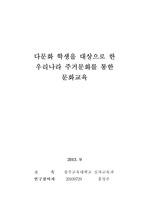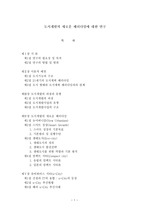

-
 * 본 문서는 배포용으로 복사 및 편집이 불가합니다.
* 본 문서는 배포용으로 복사 및 편집이 불가합니다.
미리보기
서지정보
· 발행기관 : 한국주거학회
· 수록지 정보 : 한국주거학회논문집 / 22권 / 2호
· 저자명 : 김민석
목차
I. 서 론
II. 관련 이론 및 선행연구 고찰
III. 분석방법 수립
IV. 공간분석 결과
V. 결 론
참고문헌초록
건축 공간의 분석에 있어서, 단위 공간간의 관계성에 기반하여 공간구조 전반의 배치적(configurational) 속성을 분석하는 데 유용한 분석 기법으로 공간구문론(Space Syntax)을 들 수 있는데, 이를 통하여 특정 건축 공간에 있어서 각 단위공간의 사회적 중심성을 위상학적 측면에서 정량적으로 파악할 수 있다. 본 연구에서는 먼저 공간구문론 기법의 적용에 있어서 분석 대상 주거 공간들의 특성에 따라 요구되는 방법론적 장치들을 설정하고, 이를 통하여 분석 대상 주거 공간들을 분석하고 각각 비교한 후, 그 문화적·행태적 의미를 해석하고자 한다.영어초록
Until now, several comparative approaches were developed within the studies of Korean, Chinese, and Japanese traditional housings. In those studies, however, each space in the traditional houses was only treated in individual and fragmentary manners, and they lacked the interpretation of the topological attribute of each space within a holistic structure organized by unit spaces, and of the cultural-behavioral meaning of them within a holistic space-use pattern of the housing. The topological attribute and behavioral meaning can be analyzed and interpreted with the quantitative spatial analysis method such as Space Syntax. This study aims to analyze the traditional housings in Korea, China and Japan in the holistic aspect of spatial structure using Space Syntax, and to compare the analysis results with relating thestructural attributes to the space-use pattern. In this study, the ‘Banga’ in Chosun era, the 'Siheyuan' in Ming-Ching era, and the ‘Shoinzukuri’ in Edo era were selected as the analysis subjects. The integration indices were calculated from the convex maps representing the subjects, and the common and different attributes of the three subjects were definedthrough comparative analyses참고자료
· 없음태그
-
자료후기
-
자주묻는질문의 답변을 확인해 주세요

꼭 알아주세요
-
본 학술논문은 (주)학지사와 각 학회간에 저작권계약이 체결된 것으로 AgentSoft가 제공 하고 있습니다.
본 저작물을 불법적으로 이용시는 법적인 제재가 가해질 수 있습니다. -
해피캠퍼스는 구매자와 판매자 모두가 만족하는 서비스가 되도록 노력하고 있으며, 아래의 4가지 자료환불 조건을 꼭 확인해주시기 바랍니다.
파일오류 중복자료 저작권 없음 설명과 실제 내용 불일치 파일의 다운로드가 제대로 되지 않거나 파일형식에 맞는 프로그램으로 정상 작동하지 않는 경우 다른 자료와 70% 이상 내용이 일치하는 경우 (중복임을 확인할 수 있는 근거 필요함) 인터넷의 다른 사이트, 연구기관, 학교, 서적 등의 자료를 도용한 경우 자료의 설명과 실제 자료의 내용이 일치하지 않는 경우
“한국주거학회논문집”의 다른 논문도 확인해 보세요!
-
가로변 건축물 파사드의 관리 방향 설정에 관한 연구 9 페이지
본 연구는 공공정책으로 대변화가 예정된 전이지역에 위치하여 경계부 가로변 건축물의 내외적 변화가 예상되고, 선택적 적용에 의한 맥락적 관리가 필요한 광주광역시 국립아시아문화전당(이하 ‘문화전당’이라 함) 건립예정지 경계부의 가로변 건축물 파사드를 대상으로 연구를 진행하였다. 그리고 문화전당의 열린공간적 성격을 강화하고, 적절한 공간의 규정을 위해 가로변 건.. -
1-2인가구의 라이프스타일과 소형주택 요구도에 관한 연구 9 페이지
본 연구는 소형주택의 주요 수요층이라 할 수 있는 1-2인 가구를 대상으로 라이프스타일과 주거의식을 조사하고 그들의 주거요구도를 파악하여 향후 소형주택 개발의 기초자료를 제시하고자 한다. -
어린시절 집에 대한 장소애착이 주거만족도에 미치는 영향 10 페이지
본 연구의 목적은 어린시절 집에 대한 장소애착을 미국 미시간의 대학생 자료를 중심으로 파악하고, 주거만족도와의 관련성을 파악하려는 것이다. 그럼으로써 아동기장소애착 척도를 정립하고자 하는 것이며, 나아가 장소애착을 주거만족도 이론과 연계 확대하려는 것이다.구체적인 연구내용은 첫째, 선행연구의 척도1)를 기준으로 어린시절 집에 대한 장소애착 척도를 발전시키고.. -
청주 원도심 내 현존하는 옛마을의 공간구성 변화 9 페이지
본 연구에서는 이러한 점에 초점을 두고서 현존하고 있는 옛마을 중, 마을의 주진입로인 안길을 비롯하여 가로 및 필지체계가 비교적 양호하게 유지되고 있는 탑동의 양달말2)을 선정하여 가로 및 필지의 변화에 따른 주택들의 배치특성에 대한 분석을 통하여 옛마을 공간구성의 변화를 밝히고자 하는 것이다. 연구의 진행방법은 2010년 배치도(현황)을 토대로 1968년.. -
공동주택단지 보행공간의 주민만족도 분석 8 페이지
본 연구는 공동주택단지의 주거환경에 지대한 영향을 미치는 보행공간의 질적 평가지표를 설정하고, 대구광역시에 건설된 아파트단지를 대상으로 하여 보행공간 구성요소별 이용특성을 분석한다. 그리고 주동배치유형에 따른 보행환경 평가요소별 주민만족도를 비교분석해 봄으로 써, 향후 공동주택단지의 계획 및 설계과정에 있어서 보다 안전하고 편리하며 쾌적한 보행환경 설계를 ..
찾으시던 자료가 아닌가요?
지금 보는 자료와 연관되어 있어요!
문서 초안을 생성해주는 EasyAI




